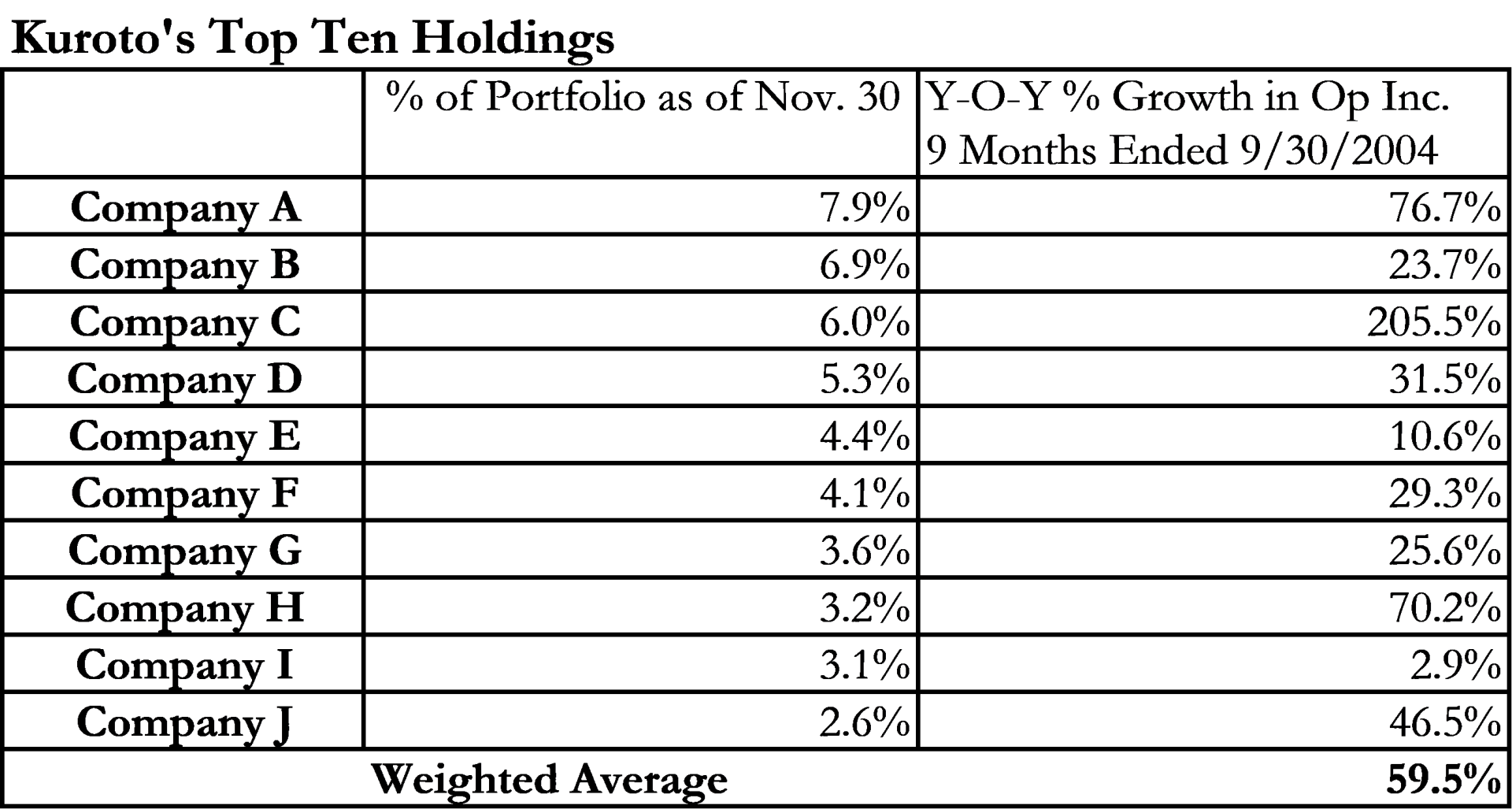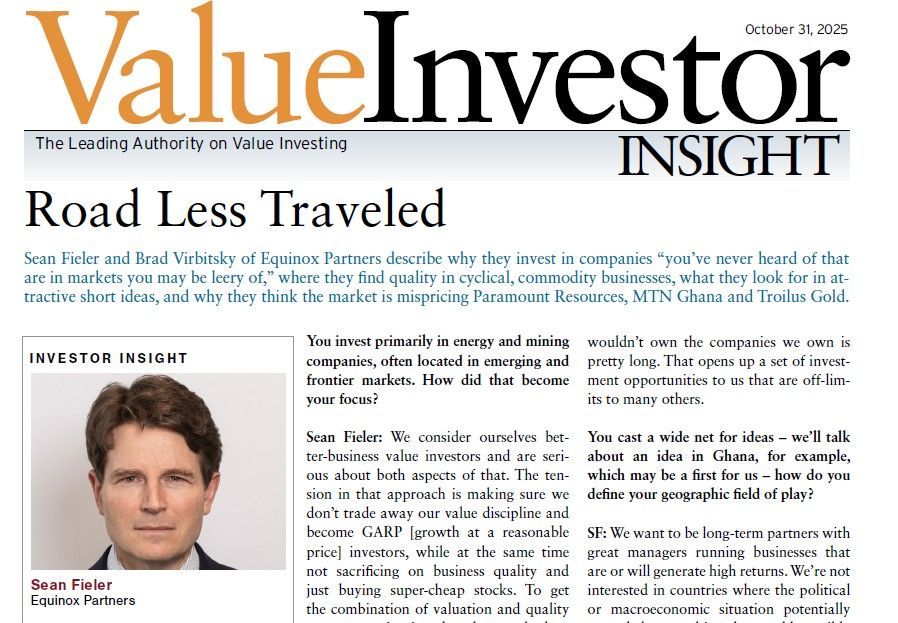Kuroto Fund, L.P. - Q3 2004 Letter
Dear Partners and Friends,
Kuroto Closes to New Investors
As of 1 October 2004, Kuroto is closed to new investors. Capacity permitting, existing limited partners may continue to add to their positions in the fund at scheduled quarterly openings.
Growing Earnings
For years, Kuroto has extolled the mundane character of the businesses in which we invest. Our companies’ lack of sex appeal is surely one of the principal reasons why they sell for such low valuations. Until the boring streams of free cash flow they generate are properly appreciated by the market, we will remain their enthusiastic owners.
There is, however, nothing boring about the rate of progress in our holdings’ earning power. Highly profitable branded dairy product, personal soap and retail banking businesses may be mature in the West, but in much of Asia, their organic growth, stimulated by robust disposable income expansion, is proving to be quite exciting.
To illustrate, Kuroto’s top ten holdings enjoyed a 59.5% weighted average increase in operating earnings for the first nine months of 2004. Adjusting for one extraordinary outlyer, the weighted earnings growth for the remaining nine companies was still an impressive 37.1%.
Asian Currency Appreciation
The long awaited depreciation of the US dollar against Asian currencies has finally begun. As of the writing of this letter, the US dollar’s decline has already added about five percent to Kuroto’s fourth quarter performance. We remain convinced that the prolonged undervaluation and pending revaluation of Asia’s currencies will rank as one of the most important economic events of our financial era.
We are stockpickers at heart and do not pretend to understand all of the economic and geopolitical consequences of the continued mispricing of the US dollar. That said, we insist that the effects of the US dollar’s present sizable overvaluation vis-à-vis America’s Asian trading partners should be front and center in any sensible investor’s strategy. The prevailing exchange rates between America and Asia have:
- fueled large and persistent external imbalances in US and Asian economies
- kept a lid on US interest rates
- forced Europe to bear a disproportionate share of the US dollar’s recent adjustment
- encouraged expansionary monetary policies in Asia
- over-stimulated investment in Asia and subsidized over-consumption in the US
Given the size and scope of these economic imbalances, the pending appreciation of Asia’s currencies, particularly against the US dollar, is certain to ripple through the vast majority of the world’s financial markets (think “wave” not “ripple”).
As investors in Asia, we have devoted considerable time to pondering the best method for profiting from the changes envisaged above. Kuroto has long trumpeted our significantly net-long exposure to assets that should appreciate in US dollar terms. We have also largely avoided owning Asian export businesses, recognizing the difficulties they would face should the US dollar decline substantially. Instead, our portfolio is concentrated in local businesses with local brands and franchises that are selling their products and services to locals in local currency terms. Lastly, we’ve considered our fund’s vulnerability to a possible disorderly adjustment in China’s economic and financial structure that may ensue from the eventual change in that country’s foreign exchange rate policy.
China, with its pegged currency and large current account surplus with the US, is very much at the center of Asia’s dysfunctional currency markets. In his book, The Dollar Crisis, Richard Duncan makes a compelling case for the long-term connection between a country’s capital inflows via large current account surpluses (with their attendant rapid growth in credit) and the investment bubble that they ultimately create. As his book makes clear, “…the [Asian] countries that built up large stockpiles of international reserves ($) through current account or financial account surpluses experienced severe economic overheating and hyperinflation in asset prices that ultimately resulted in economic collapse.”
China enjoyed extraordinary economic performance during the last decade, and much of this growth was dependent upon China’s large and growing trade imbalance with the world’s leading manufacturer of US dollar liabilities, America. As Duncan predicts, China’s growing external imbalances coincided with an extraordinary Chinese capital investment boom. This connection between China’s external imbalances and domestic capital investment begs several questions: What would happen to China’s economy were the renminbi to appreciate enough to correct these external imbalances? Would, as a result, China’s monetary policy necessarily turn contractionary? Would the Chinese capital investment cycle be likely to turndown? How severe might China’s post boom hangover be? Would China’s rickety banking system be able to cope with the resulting deterioration in the credit quality of its borrowers? We do not know the answers to these questions, but clearly the degree to which China successfully navigates a currency rebalancing could have a meaningful impact on the extent to which Kuroto benefits from the appreciation of Asia’s other currencies.
For a multitude of reasons, most of them company specific, Kuroto has no long positions in the People’s Republic of China. We are, however, looking for compelling short investments ideas that would have the effect of hedging Kuroto’s portfolio against a large decline in Chinese economic activity.
In conclusion, Kuroto continues to look forward to the eventual adjustment of our currency versus those of our Asian trading partners. In the next few years, we expect currency appreciation to significantly compound the gains we anticipate generating from our ownership of outstanding Asian businesses trading at discount valuations.
Sincerely,
Sean Fieler
William W. Strong










